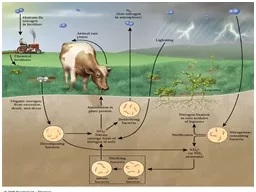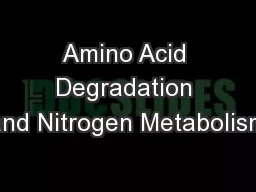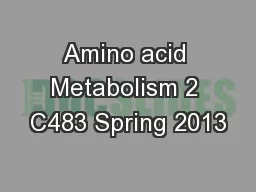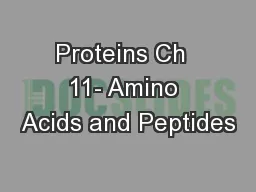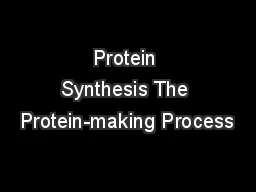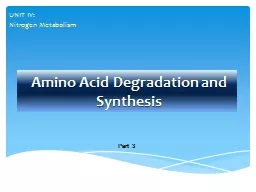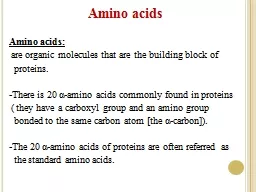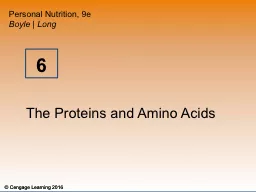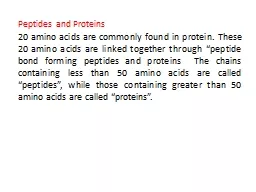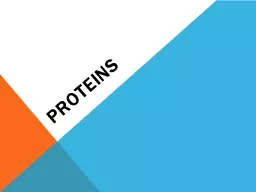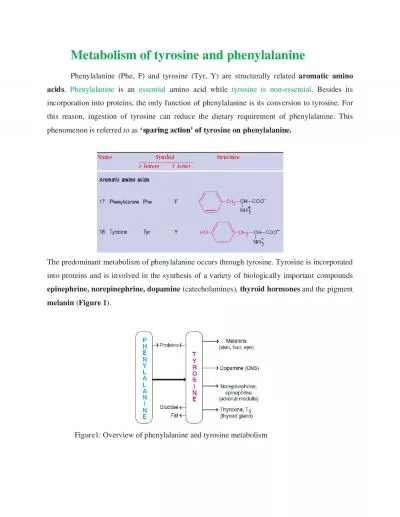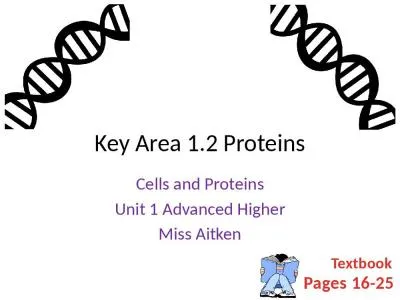PPT-Amino Acid Metabolism The continuous degradation and synthesis of cellular proteins occur
Author : ida | Published Date : 2022-02-12
Approximately 75 are reutilized The excess nitrogen forms urea Proteins represent 1015 of total energy supply Digestion and Absorption of Proteins The α amino
Presentation Embed Code
Download Presentation
Download Presentation The PPT/PDF document "Amino Acid Metabolism The continuous deg..." is the property of its rightful owner. Permission is granted to download and print the materials on this website for personal, non-commercial use only, and to display it on your personal computer provided you do not modify the materials and that you retain all copyright notices contained in the materials. By downloading content from our website, you accept the terms of this agreement.
Amino Acid Metabolism The continuous degradation and synthesis of cellular proteins occur: Transcript
Approximately 75 are reutilized The excess nitrogen forms urea Proteins represent 1015 of total energy supply Digestion and Absorption of Proteins The α amino group of many amino acids is transferred to . CHAPTER 3, Part 1 . Amino Acids and Peptides . To know the structure and naming of all 20 protein amino acids. To know the structure and properties of peptides and the particularly the structure of the peptide bond.. Chapter 30, . Stryer. Short Course. Overview. Amino Acid Catabolism. Nitrogen removal. Urea Cycle. Metabolism of carbon backbone. Amino acid catabolism. Amino acids . from diet or protein turnover. Salvaged for use in proteins or catabolized. 1. Arginine is biosynthesized from this precursor:. Pyruvate. Oxaloacetate. . a. -. ketoglutarate. 3-phosphoglycerate. 2. A . Roundup Ready plant is one that has been genetically modified so that an enzyme (EPSP synthase) can no longer bind to the active ingredient (. Unit objectives:. Identify amino acid classifications based on nutritional use and chemical properties of side chains. Describe the primary, secondary, tertiary and quaternary structures of proteins. Protein Synthesis (Gene Expression) Notes. Proteins . (Review). Proteins make up all . living. materials. Proteins are composed of . amino acids. – there are . 20. . different amino acids. Different . building blocks for protein synthesis. precursors of nucleotides and heme. source of energy. neurotransmitters. precursors of neurotransmitters and hormones. Outline of amino acid degradation. The liver is the major site of degradation for most amino acids, but muscle and kidney dominate the degradation of specific ones. UNIT IV:. Nitrogen Metabolism. Part . 3. Neonatal screening and diagnosis of PKU: . Early . diagnosis of phenylketonuria is important because the disease is treatable by dietary means. . Because of the lack of neonatal symptoms, laboratory testing for elevated blood levels of phenylalanine is mandatory for detection. . . are organic molecules that are the building block of . . proteins. .. -There is 20 . α. -amino acids commonly found in . proteins. . ( . they . have a carboxyl group and an amino group . . . 6. 6.1 Differentiate . between essential amino acids and nonessential amino acids.. 6.2 List . the functions of protein in the body.. 6.3 List . the steps for protein digestion and absorption in the body. . Each amino acid (aa) shares a common structure; i.e. an amine (NH. 2. ) group, an acid group (COOH), and a central carbon atom bonded to hydrogen and to a side chain (R).. The side chains qualify aas as acidic, basic, neutral, aromatic, and sulphur-containing amino acids.. Peptide bond formation. : . α-carboxyl group of one amino acid (with side chain R1) forms a covalent peptide bond with α-amino group of another amino acid . ( . with the side chain R2) by removal of a molecule of water. The result is : Dipeptide ( i.e. Two amino acids linked by one peptide bond). By the same way, the dipeptide can then forms a second peptide bond with a third amino acid (with side chain R3) to give . . Amino . Acids are the building units of proteins. There are about 300 amino acids occur in nature. Only 20 of them enter in proteins synthesis.. . Structure of amino acids:. Four different . groups . Phenylalanine (Phe, F) and tyrosine (Tyr, Y) are structurally related aromatic amino acids . Phenylalanine is an essential amino acid while tyrosine is non - essential . Besides its incorporation i Unit 1 Advanced Higher. Miss Aitken. Pages 16-25. Textbook. Proteomics. Genome:. complete set of DNA. Comprises of coding and non-coding areas. 20-25000 genes in human genome. Proteome:. Entire set of proteins that can be expressed from a genome.
Download Document
Here is the link to download the presentation.
"Amino Acid Metabolism The continuous degradation and synthesis of cellular proteins occur"The content belongs to its owner. You may download and print it for personal use, without modification, and keep all copyright notices. By downloading, you agree to these terms.
Related Documents

